Iolite is a mineral and gemstone that is also known as “water sapphire” due to its striking blue-violet to violet-blue color. It is a relatively rare gemstone and is valued for its unique and appealing appearance. Iolite has been used for various purposes throughout history, including as a gemstone in jewelry and as a navigational aid.
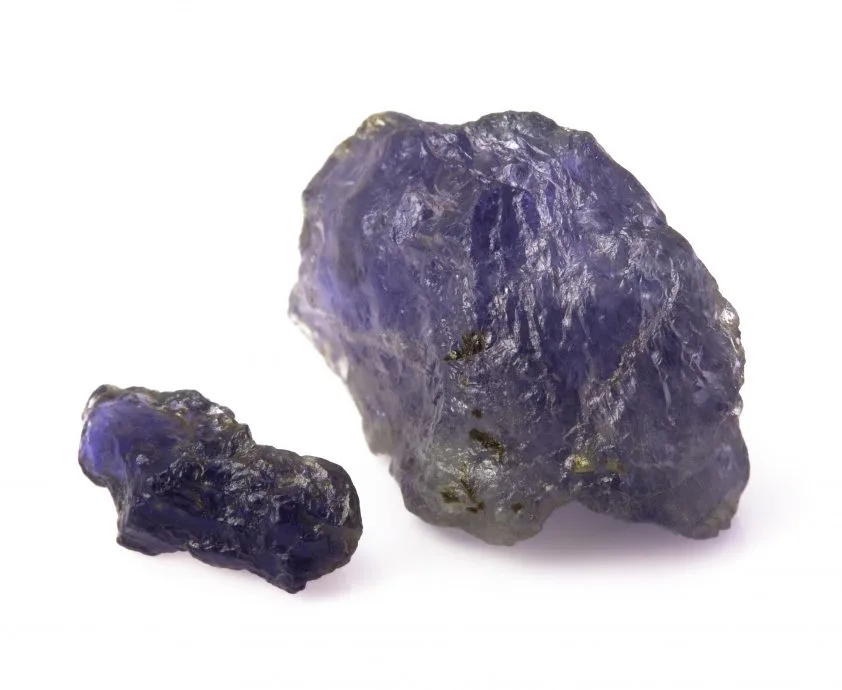
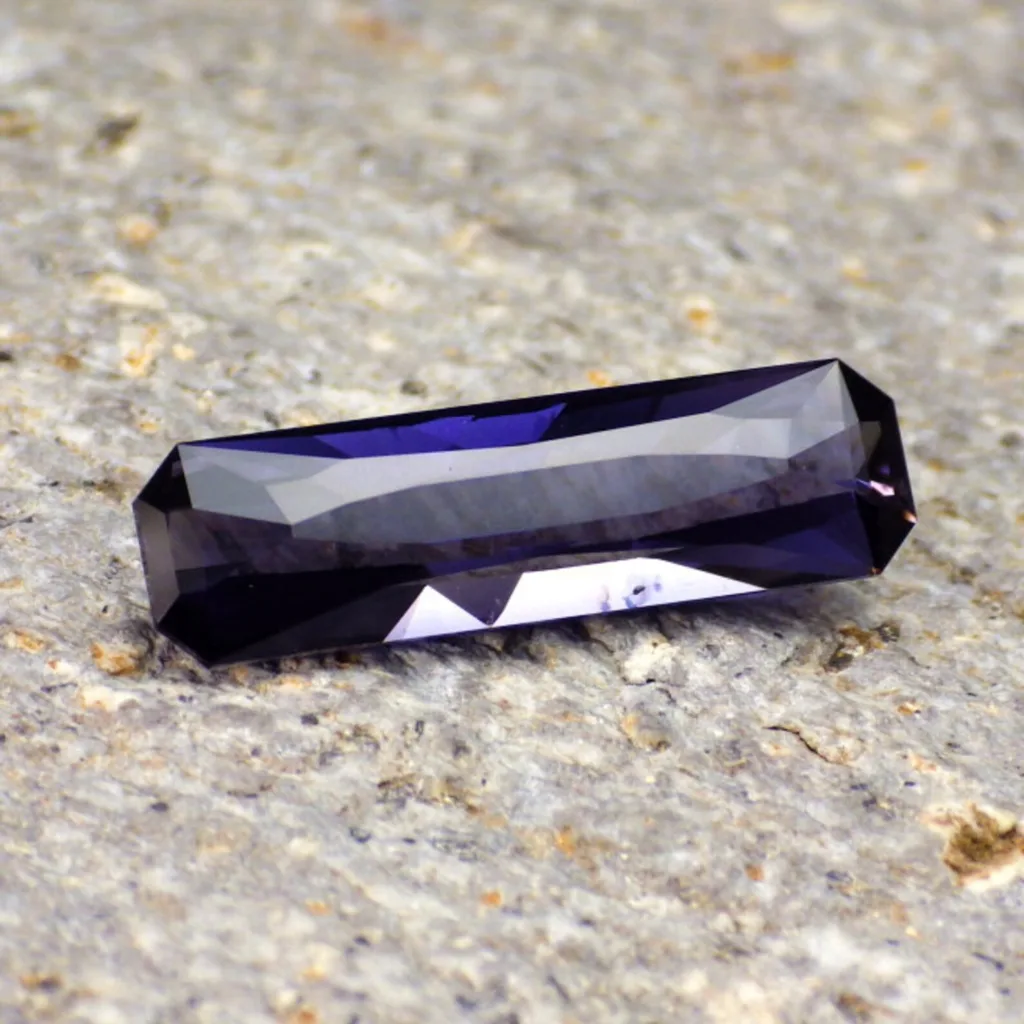
Definition: Iolite is a gemstone characterized by its striking blue-violet to violet-blue color. It is a rare mineral used in jewelry, valued for its unique appearance and durability. Iolite is also known as “water sapphire” due to its captivating resemblance to sapphires.
History: Iolite has a rich history, with notable connections to navigation. Vikings, in particular, used thin slices of iolite as a navigational aid. By looking through iolite, they could determine the precise position of the sun, even on overcast days, helping them navigate the open seas. This ability earned iolite the nickname “Viking’s Compass.” The gemstone has also been used for centuries in jewelry and ornamental purposes.
Naming: The name “iolite” is derived from the Greek word “ios,” meaning violet, which aptly describes the gem’s predominant color. It was officially named “iolite” in the 19th century, replacing its earlier name, “dichroite,” which referred to its pleochroic property of displaying different colors when viewed from different angles.
Iolite’s Geological Formation

Iolite is a mineral that forms under specific geological conditions. It is primarily found in metamorphic rocks and is associated with the following geological processes:
- Metamorphism: Iolite typically occurs in metamorphic rock formations. Metamorphism is a geological process in which existing rocks, such as shale or schist, undergo changes in mineral composition, texture, and structure due to high temperature and pressure. Iolite can develop from the alteration of minerals like mica and feldspar during this process.
- Regional Metamorphism: Iolite is often found in areas that have experienced regional metamorphism, where large portions of the Earth’s crust are subjected to substantial pressure and heat. During such regional metamorphism, rocks are buried deep within the Earth’s crust, and as a result, the minerals within them recrystallize and form iolite crystals.
- Parent Rocks: Iolite can be found in association with rocks like schist and gneiss, which are common products of regional metamorphism. These parent rocks often contain minerals that transform into iolite under the right geological conditions.
- Mineral Composition: The chemical composition of iolite is complex, consisting of magnesium, aluminum, silicon, and oxygen, along with trace elements. The exact mineral composition and the presence of impurities influence the specific color and properties of the iolite crystals.
- Local Geological Factors: Local geological conditions, including the presence of certain mineral deposits and the temperature and pressure at which metamorphism occurs, can determine the quality, size, and color of iolite deposits in a particular region.
Iolite’s formation is a result of the intricate interplay of geological processes over extended periods, making it a relatively rare and precious gemstone. Its distinct blue-violet to violet-blue color, coupled with its geological history, contributes to its desirability in the world of gemology and jewelry.
Historical Significance and Lore
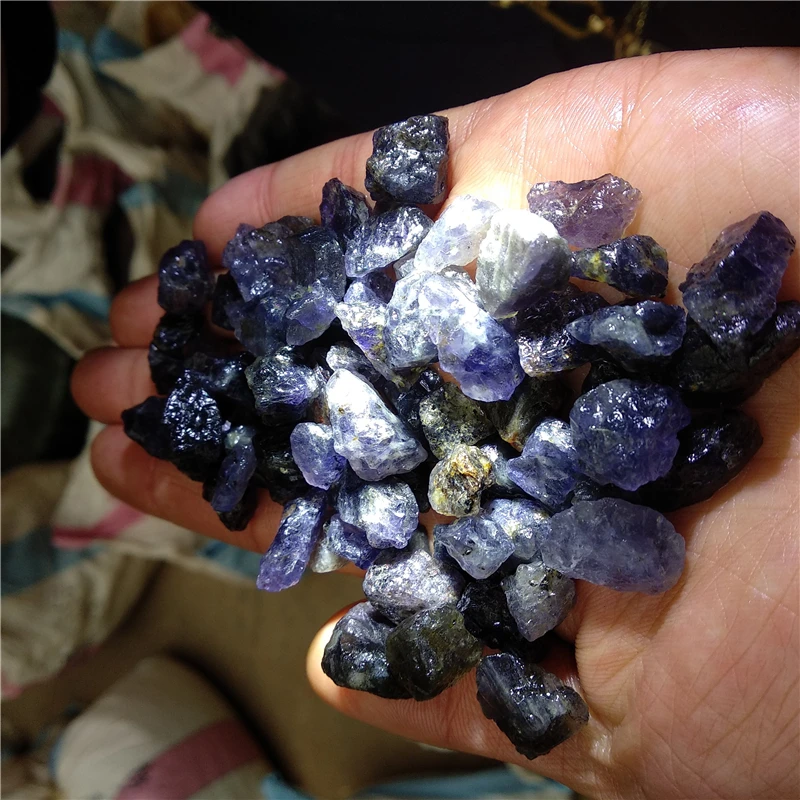
Iolite has a fascinating historical significance and lore, particularly due to its use in navigation and its mystical attributes:
- Viking’s Compass: Iolite is often referred to as the “Viking’s Compass” because of its use by ancient Viking mariners. Norse seafarers are believed to have used thin slices of iolite as a polarizing filter to determine the exact position of the sun, even on overcast days. This unique property of iolite aided them in navigation and allowed them to find their way across the open seas.
- Navigation Aid: Iolite’s pleochroic property, which causes it to display different colors when viewed from different angles, made it invaluable for navigators. By observing the shifting colors of iolite, sailors could accurately locate the sun, helping them maintain their course and determine their direction.
- Mystical and Spiritual Beliefs: Iolite is often associated with various mystical and metaphysical attributes. Some people believe that iolite has the power to enhance intuition, insight, and self-awareness. It is said to promote mental clarity, enhance psychic abilities, and help individuals overcome challenges. It is also associated with the Third Eye chakra, a concept in Hindu and yogic traditions related to inner perception and spirituality.
- Healing and Well-Being: In alternative healing practices, iolite is thought to have a range of therapeutic properties. It is believed to aid in relieving stress, enhancing vision, and balancing energy. Some claim that it can help with insomnia, alleviate headaches, and promote emotional healing.
- Jewelry and Fashion: Beyond its historical and mystical significance, iolite is a popular gemstone in contemporary jewelry. Its alluring blue-violet to violet-blue color makes it an attractive choice for rings, necklaces, and earrings.
Iolite’s unique combination of historical use in navigation and its mystical allure contribute to its enduring popularity and cultural significance. Whether appreciated for its rich history, metaphysical qualities, or aesthetic appeal, iolite continues to captivate people around the world.
Iolite’s Physical and Chemical Properties
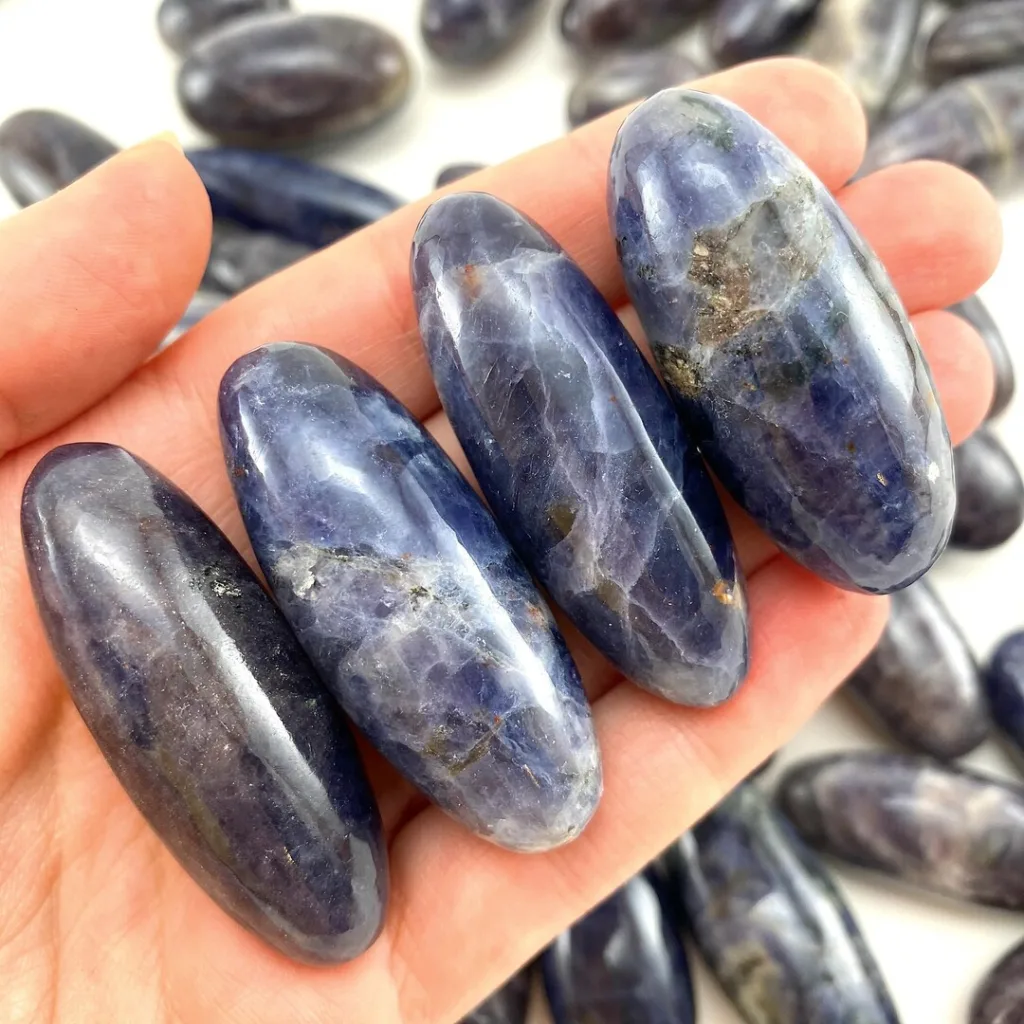
Iolite, a gemstone known for its unique color and properties, has distinct physical and chemical characteristics:
Physical Properties:
- Color: Iolite exhibits a range of colors from blue to violet, often with a grayish or greenish undertone. Its pleochroic property means it can appear different colors when viewed from various angles.
- Transparency: Iolite is typically transparent to translucent, but some specimens can be nearly opaque.
- Luster: It has a vitreous or glassy luster when cut and polished.
- Hardness: On the Mohs scale of mineral hardness, iolite scores around 7 to 7.5, making it durable enough for use in jewelry but not as hard as some other gemstones like diamonds or sapphires.
- Cleavage: Iolite has good cleavage in one direction, meaning it can be split along specific planes when subjected to stress.
- Fracture: It exhibits a conchoidal fracture, which is a smooth, curved break similar to glass.
- Specific Gravity: The specific gravity of iolite typically falls within the range of 2.58 to 2.66.
Chemical Properties:
- Chemical Composition: Iolite is a mineral belonging to the cordierite group. Its chemical formula is (Mg, Fe)2Al4Si5O18. This composition consists of magnesium (Mg), iron (Fe), aluminum (Al), silicon (Si), and oxygen (O), along with trace elements.
- Crystal System: Iolite crystallizes in the orthorhombic crystal system, forming elongated, prismatic crystals.
- Refractive Index: The refractive index of iolite ranges from approximately 1.522 to 1.578, indicating how the gemstone bends and refracts light.
- Birefringence: Iolite is strongly birefringent, meaning it can split light into two separate rays, causing a doubling effect when viewing the gem through a polarizing filter.
- Dispersion: Iolite has low dispersion, which means it doesn’t exhibit the same fiery brilliance as some other gemstones like diamonds.
These physical and chemical properties contribute to iolite’s unique appearance, including its pleochroic nature, and its suitability for use in various types of jewelry. It’s important to understand these properties when evaluating and working with iolite gemstones.
Iolite’s Unique Optical Features
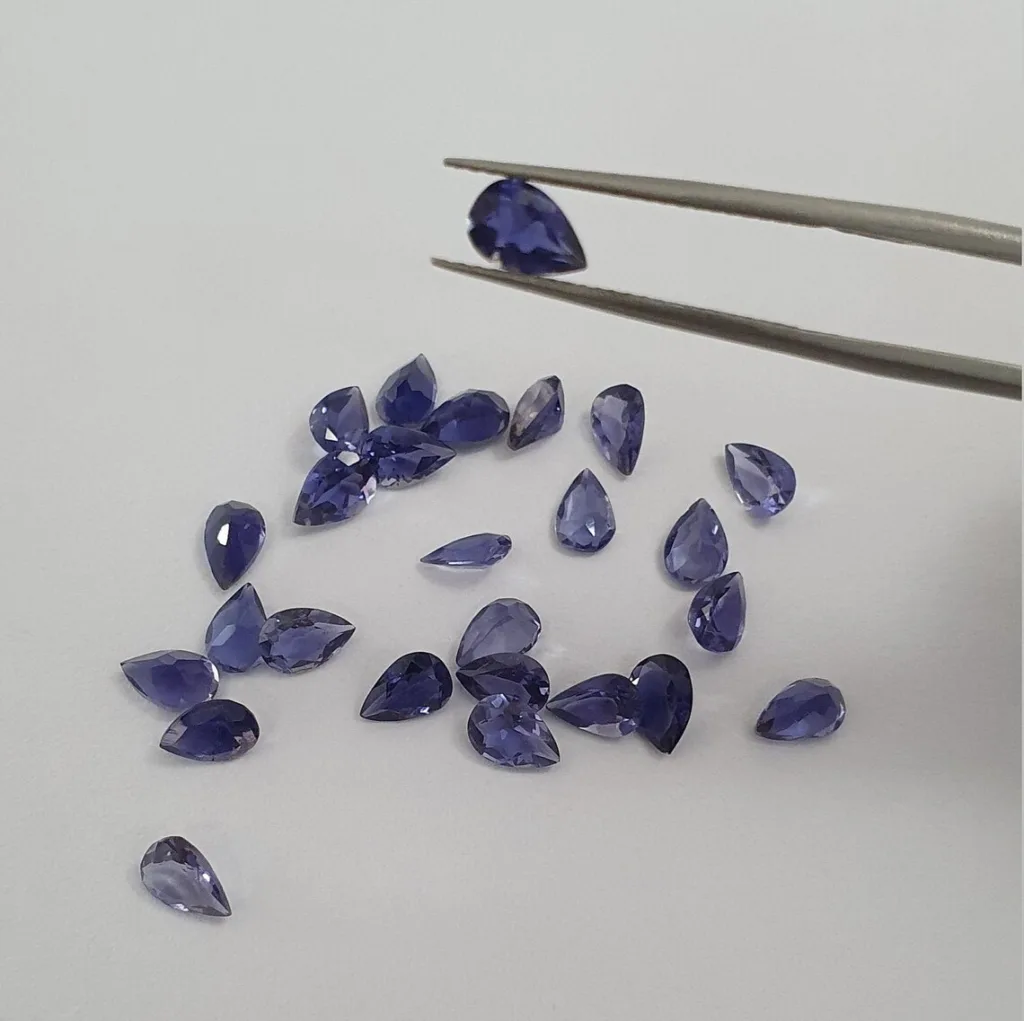
Iolite possesses several unique optical features that contribute to its distinct appearance and desirability as a gemstone:
- Pleochroism: One of the most notable optical features of iolite is its pleochroism. Pleochroism is the phenomenon where a mineral or gemstone appears to display different colors when viewed from different angles. In the case of iolite, it can exhibit shades of blue, violet, and grayish or greenish tints, depending on the angle of observation. This pleochroic property is a key distinguishing characteristic of iolite and adds to its visual appeal.
- Strong Birefringence: Iolite is strongly birefringent, which means it has the ability to split a single ray of light into two rays, each of which travels at a different speed through the gem. This results in a doubling effect when viewing iolite through a polarizing filter. Birefringence is responsible for the doubling of facets and the presence of two distinct sets of facets when looking through iolite, particularly in the facet edges.
- Trichroism: In some cases, iolite may exhibit trichroism, which is a more advanced form of pleochroism. Trichroic gemstones show three different colors when viewed from different angles, and iolite can display this property with varying shades of blue, violet, and a light gray or greenish hue.
These optical features make iolite a captivating and unique gemstone. Its color-shifting abilities, combined with its pleasing blue-violet hues, make it an attractive choice for jewelry designers and gemstone enthusiasts. However, these optical properties can also present challenges for gem cutters, as they must carefully align the stone to showcase its most appealing color and minimize the doubling effect caused by birefringence.
Iolite’s Sources and Mining
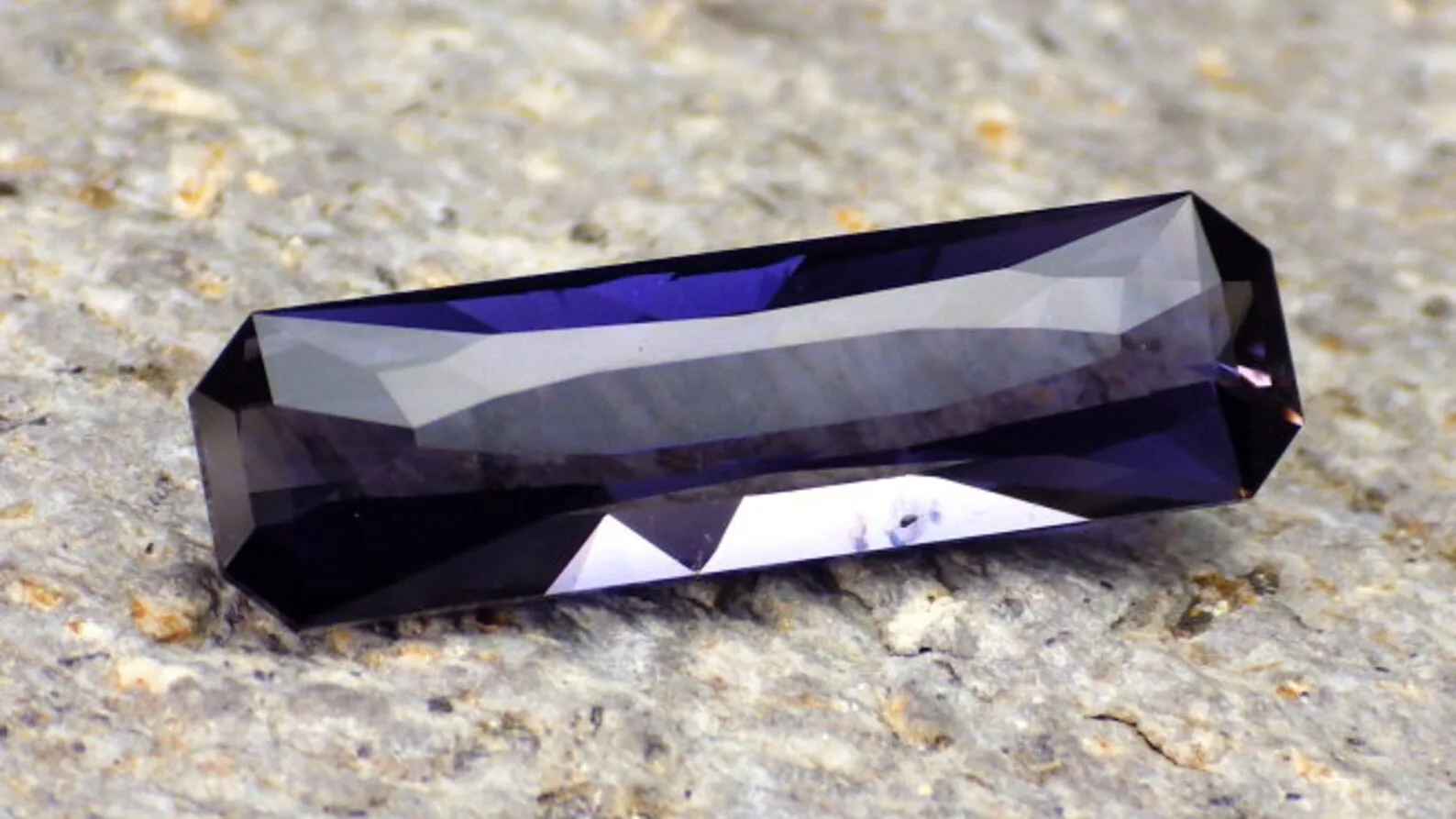
Iolite is found in various locations around the world, and mining for this gemstone involves extracting it from specific geological formations. Here are some of the primary sources and methods of mining iolite:
- India: India is a notable source of iolite, with the state of Orissa being one of the main production areas. Iolite deposits in India are often associated with metamorphic rocks, and they are mined using traditional techniques, such as hand tools and small-scale excavation.
- Madagascar: Madagascar is another significant producer of iolite. The gemstone is often found in the southern regions of Madagascar, where deposits are situated in metamorphic rock formations. Local miners extract iolite through small-scale operations, including hand digging and basic processing.
- Sri Lanka: Sri Lanka, known for its gem-rich lands, also yields iolite, particularly in the Ratnapura district. Here, iolite is found in alluvial deposits and weathered rock, making it relatively accessible for artisanal miners.
- Brazil: Iolite can be found in certain regions of Brazil, primarily in pegmatites and schist formations. Brazilian mining operations tend to be small-scale, and miners use basic tools to extract iolite from the host rock.
- United States: The United States, particularly the state of Wyoming, is known for its iolite deposits. The stone is found in metamorphic rocks and is occasionally mined by rock and mineral enthusiasts as well as commercial miners.
Iolite mining often involves simple tools and techniques, such as hand digging, chiseling, and basic processing to extract the gemstone from its host rock. Due to its relatively limited availability and the remote locations of some deposits, iolite is not as widely mined as more abundant gemstones like diamonds or sapphires. Nevertheless, its unique color and historical significance contribute to its desirability, and it remains a sought-after gemstone in the jewelry market.
Iolite in Jewelry
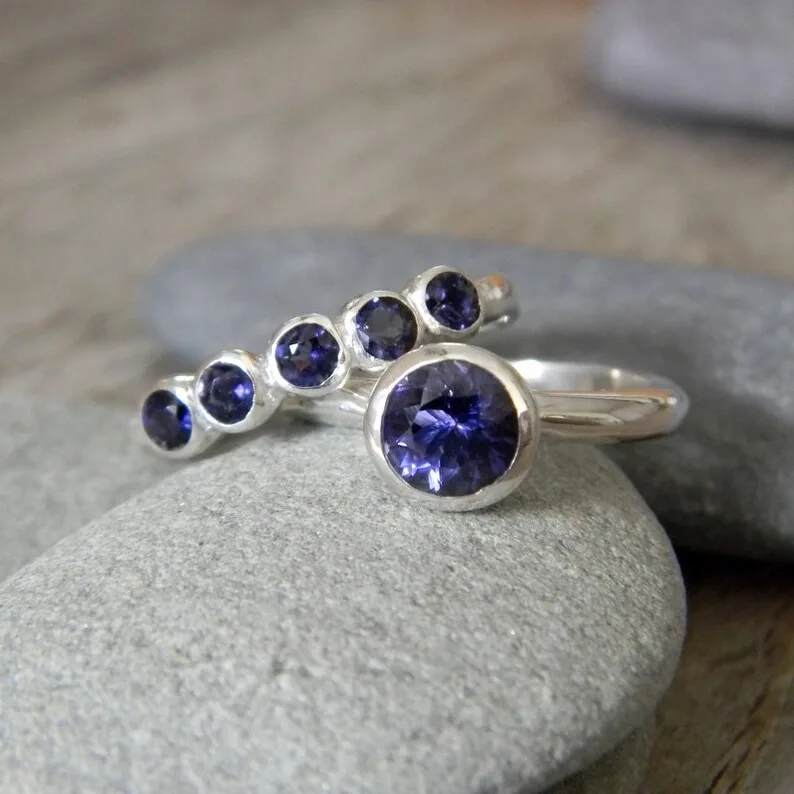
Iolite’s unique and captivating blue-violet to violet-blue color, coupled with its historical significance, makes it a popular choice for jewelry. Here’s how iolite is used in jewelry:
- Gemstone Rings: Iolite is frequently used in rings, both as center stones and accent stones. Its vibrant color adds a touch of elegance to various ring designs. Iolite rings are popular for engagement rings, cocktail rings, and everyday wear.
- Earrings: Iolite is commonly set in earrings, either as studs or dangles. Its alluring color complements various skin tones and outfits, making it a versatile choice for both casual and formal occasions.
- Necklaces and Pendants: Iolite pendants and necklaces are popular due to the gemstone’s eye-catching color. They come in a variety of designs, from simple solitaire pendants to elaborate, multi-stone necklaces.
- Bracelets: Iolite is sometimes used in bracelet designs. Whether as a single focal stone or in combination with other gemstones, iolite bracelets add a touch of elegance to the wrist.
- Brooches and Pins: Iolite can also be featured in brooches and pins, adding a pop of color to various accessories. These pieces can be both decorative and functional, holding scarves or clothing in place.
- Beaded Jewelry: Iolite beads are used to create beaded jewelry, such as bracelets and necklaces. These jewelry pieces often have a natural, bohemian look, showcasing the stone’s raw beauty.
- Mixed Gemstone Jewelry: Iolite is frequently combined with other gemstones in multi-stone jewelry pieces. This blending of colors and textures allows designers to create stunning, unique jewelry items.
- Custom Jewelry: Many people opt for custom-designed jewelry featuring iolite. Customization allows individuals to create one-of-a-kind pieces that cater to their personal preferences and style.
Iolite’s pleochroism, which results in its display of various colors when viewed from different angles, adds a dynamic and intriguing element to jewelry designs. Jewelry makers and wearers appreciate its versatility, as it complements both contemporary and vintage styles. Whether used as a focal point or alongside other gemstones, iolite’s unique beauty and cultural significance continue to make it a sought-after gem in the world of jewelry.
Iolite as a Gemstone Investment
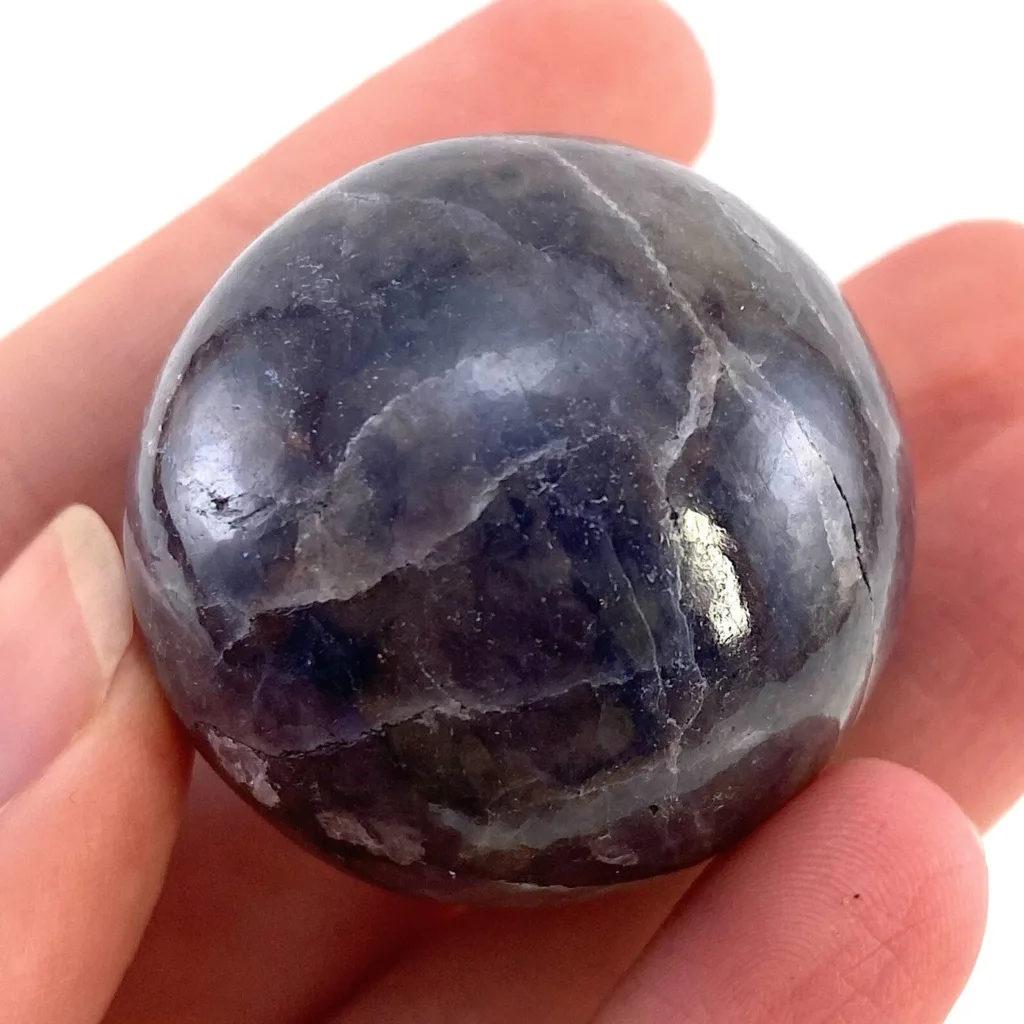
Investing in gemstones, including iolite, is a unique and potentially profitable venture. However, it comes with its own set of considerations and risks. Here are some factors to keep in mind if you are considering iolite as a gemstone investment:
1. Rarity and Demand: Iolite is relatively rare, especially in high-quality gemstone form, which can increase its investment potential. The demand for iolite may be influenced by factors like fashion trends, historical significance, and the gem’s unique properties.
2. Quality and Grading: The value of an iolite gemstone is closely tied to its quality, including color, clarity, cut, and carat weight. Well-cut, vividly colored, and transparent iolite gemstones are more valuable. It’s crucial to have your iolite properly graded by a reputable gemological laboratory to assess its quality accurately.
3. Market Trends: Like any investment, the value of gemstones can fluctuate based on market conditions. It’s important to stay informed about the gemstone market and trends. Keep in mind that while certain gemstones like diamonds and rubies have established markets, the iolite market may be smaller and less predictable.
4. Authenticity and Certification: Ensure that your iolite gemstone comes with appropriate certification and documentation to prove its authenticity and quality. This can be vital when buying and selling iolite as an investment.
5. Diversification: Gemstone investment is generally considered a niche and speculative market. It’s advisable to diversify your investments, including holding a variety of gemstones or other assets to spread risk.
6. Long-Term Perspective: Gemstone investments are often best approached with a long-term perspective. It can take years or even decades for a gem’s value to appreciate significantly. Short-term fluctuations are common, so patience is crucial.
7. Storage and Security: Proper storage and security for your iolite and other gemstone investments are essential. Ensure they are stored in a safe and controlled environment to prevent damage, loss, or theft.
8. Market Liquidity: The liquidity of gemstone investments can be relatively low compared to other assets like stocks or real estate. It may take time to find a buyer for your iolite gemstone when you decide to sell.
9. Expert Advice: Consulting with experts in the field, such as gemologists or investment advisors with knowledge of the gemstone market, can be valuable when making gemstone investments.
In summary, iolite can be an interesting addition to a diversified investment portfolio, especially if you are passionate about gemstones. However, it’s essential to approach gemstone investments with caution, thorough research, and a long-term perspective. The gemstone market can be unpredictable, and the potential for profit is not guaranteed, so careful consideration is advisable.
How to Identify and Authenticate Iolite
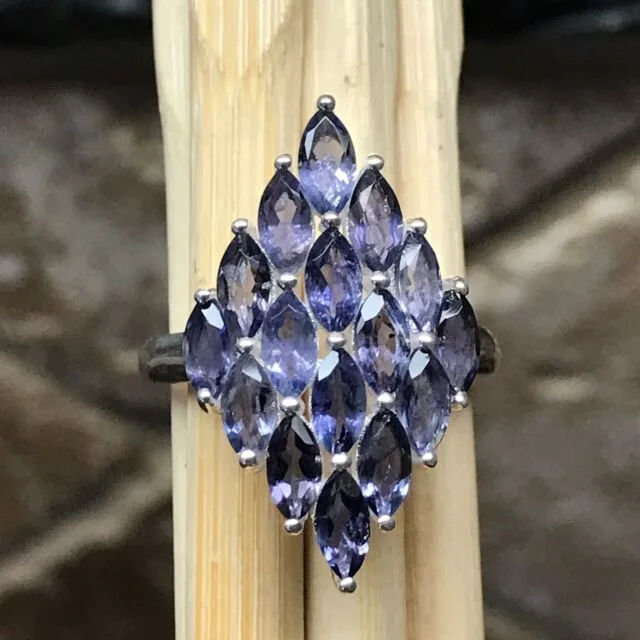
Identifying and authenticating iolite involves a combination of visual inspection, gemological testing, and documentation. Here are the key steps to determine whether a gemstone is iolite and assess its authenticity:
- Visual Inspection:
- Color: Iolite is known for its distinct blue-violet to violet-blue color. Examine the gemstone’s color under various lighting conditions. Look for pleochroism, where the stone may display different colors from different angles, shifting between blue, violet, and sometimes gray or greenish hues.
- Clarity: Inspect the gem for any visible inclusions or imperfections. Higher-quality iolite is typically more transparent with minimal inclusions.
- Luster and Transparency:
- Check the luster of the gemstone. Iolite should have a vitreous or glassy luster when polished.
- Verify the gem’s transparency. Iolite is generally transparent to translucent, but some lower-quality specimens may be nearly opaque.
- Refractive Index (RI):
- Measure the gem’s refractive index, which can provide an indication of its identity. Iolite typically has an RI ranging from approximately 1.522 to 1.578.
- Birefringence:
- Iolite is strongly birefringent, meaning it can split a single ray of light into two, causing a doubling effect when viewed through a polarizing filter. You can use a dichroscope or polariscope to detect this property.
- Specific Gravity:
- Determine the specific gravity of the gemstone, which should fall within the range of 2.58 to 2.66 for iolite.
- Fluorescence:
- Test the gemstone for fluorescence under ultraviolet (UV) light. Iolite may exhibit weak to moderate yellow fluorescence in longwave UV.
- Gemological Certification:
- Always request a gemological certificate from a reputable gemological laboratory when purchasing iolite. The certificate should confirm the gem’s identity, quality, and authenticity.
- Expert Assessment:
- If in doubt or for additional verification, seek the expertise of a certified gemologist or gemological appraiser. They can use specialized instruments and their knowledge to confirm the gem’s identity and quality.
- Documentation and Provenance:
- Keep records of the gem’s source, provenance, and any previous ownership. Authenticity can often be confirmed through a well-documented history.
- Buy from Reputable Sources:
- Purchase iolite from established and reputable gemstone dealers or jewelers. They are more likely to sell genuine, properly identified gemstones.
It’s important to note that gemstone identification can be complex, especially for professionals, and may require access to gemological tools not readily available to the average consumer. Therefore, for valuable or high-end gemstones, consulting with an experienced gemologist is strongly recommended to ensure accurate identification and authentication of iolite.
Iolite’s Use in Lapidary and Carving
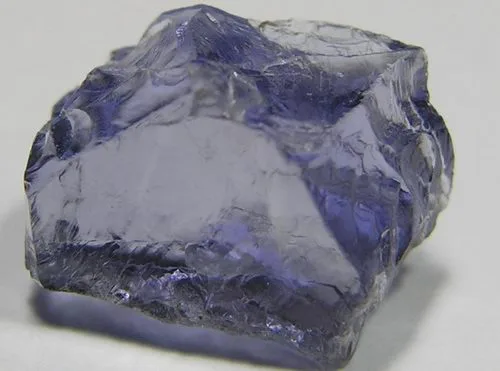
Iolite, with its unique color and pleasing properties, is a gemstone that lapidaries and carvers often appreciate for its workability and versatility. Here’s how iolite is used in lapidary and carving:
Lapidary Uses:
- Faceted Gemstones: Iolite is frequently cut into faceted gemstones for use in jewelry. The gem is shaped into various cuts, including rounds, ovals, cushions, and fancy shapes. Lapidaries carefully orient the stone to showcase its best color while minimizing the effects of pleochroism and birefringence.
- Cabochons: Iolite is also fashioned into cabochons. These smooth, polished, and often domed gemstones highlight its distinct color and can be used in rings, pendants, and earrings.
- Beads: Iolite beads are popular for creating beaded jewelry. These beads come in various shapes and sizes, offering a range of design options for jewelry makers.
- Inlays: Iolite is used in inlay work, where small pieces of the gemstone are set into jewelry, wood, or other materials to create intricate designs and patterns.
Carving:
- Sculptures: Iolite is sometimes used in sculpture and carving. Due to its relatively good hardness, lapidaries can carve intricate designs and figurines from iolite.
- Cameos: Iolite has been used to create cameos, which are carved raised relief designs on a contrasting background. This style of carving often highlights the gem’s color play and pleochroic properties.
- Intarsia: Intarsia is an artistic form of lapidary in which iolite is used alongside other gemstones to create elaborate, multi-colored mosaics or patterns. The skillful integration of various gem materials allows for intricate and eye-catching designs.
Iolite’s color-shifting properties, especially its pleochroism, can present both a challenge and an opportunity for lapidaries and carvers. On one hand, it allows for unique visual effects in jewelry and art. On the other hand, it requires careful consideration during the cutting and carving process to maximize the gem’s appeal and minimize undesirable color shifts.
Whether used in traditional faceted jewelry or in more artistic forms of lapidary and carving, iolite’s distinct characteristics make it a valuable and versatile choice for artisans and jewelry designers.
Summary of Key Points
Iolite, also known as “water sapphire,” is a unique gemstone known for its striking blue-violet to violet-blue color and its historical significance. Here are the key points to remember:
- Definition and Properties: Iolite is a gemstone with a chemical composition of (Mg, Fe)2Al4Si5O18. It is characterized by pleochroism, birefringence, and a vitreous luster. It is valued for its rarity and unique color-shifting properties.
- Historical Significance: Iolite was historically used by Vikings as a navigational aid, earning it the nickname “Viking’s Compass.” It has a rich history and cultural significance.
- Geological Formation: Iolite is primarily found in metamorphic rock formations, often associated with regions like India, Madagascar, Brazil, Sri Lanka, and the United States.
- Use in Jewelry: Iolite is used in various forms of jewelry, including rings, earrings, necklaces, and bracelets. Its pleochroic and unique color make it an attractive choice for jewelry designers.
- Gemstone Investment: Investing in iolite as a gemstone involves considerations such as rarity, quality, market trends, authenticity, and expert guidance. It can be a part of a diversified investment portfolio.
- Identification and Authentication: Authenticating iolite involves visual inspection, gemological testing, and documentation. Reputable sources and gemological certificates are essential for verifying authenticity.
- Lapidary and Carving: Iolite is used in lapidary for faceted gemstones, cabochons, beads, and inlay work. In carving, it is used for sculptures, cameos, and intarsia, highlighting its versatile nature.
Emerging Trends and Prospects for Iolite
Iolite continues to captivate the gemstone market and offers intriguing prospects for the future:
- Designer and Artisan Jewelry: Iolite is gaining popularity among jewelry designers and artisans who appreciate its unique color and versatility. Custom and handcrafted iolite jewelry is becoming more sought after.
- Ethical and Sustainable Sourcing: The trend towards ethical and sustainable sourcing of gemstones is likely to impact iolite mining practices. Responsible sourcing and fair trade practices are becoming increasingly important.
- Metaphysical and Healing Uses: Iolite’s metaphysical and healing properties are attracting interest. Some people believe it has properties related to intuition, insight, and emotional well-being, contributing to its demand.
- Education and Awareness: As consumers become more educated about gemstones, including iolite, demand for certified and authenticated gemstones may rise. This trend underscores the importance of gemological education and transparency in the industry.
- High-Quality Iolite: The demand for well-cut, high-quality iolite gemstones is expected to remain strong, especially for those with vivid color and minimal inclusions.
In conclusion, iolite’s alluring color, historical significance, and unique optical properties continue to make it a valued gemstone in the world of jewelry and gemstone enthusiasts. While it remains a niche market compared to more established gemstones, the prospects for iolite are promising, driven by its versatility, rarity, and evolving consumer preferences.




































